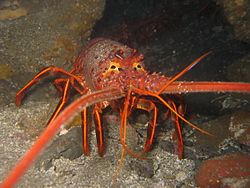Spiny lobster facts for kids
Quick facts for kids Spiny lobsters |
|
|---|---|
 |
|
| Panulirus interruptus | |
| Scientific classification | |
| Kingdom: | |
| Phylum: | |
| Subphylum: | |
| Class: | |
| Order: | |
| Family: |
Palinuridae
Latreille, 1802
|
| Genera | |
|
Jasus |
|
Spiny lobsters are also known as langustas or rock lobsters. They belong to a family called Palinuridae. There are about 60 different kinds, or species, of spiny lobsters. They are a type of crustacean, which are animals with hard outer shells, like crabs and shrimp.
In some places like Australia, New Zealand, and South Africa, people call spiny lobsters "crayfish" or "sea crayfish". But usually, the word "crayfish" is used for freshwater animals that look similar.
Contents
What Are Spiny Lobsters?
Spiny lobsters might look a lot like "true lobsters," but they are actually quite different. Both have a hard outer shell called a carapace or exoskeleton. However, spiny lobsters have very long, thick, and spiny antennae. These are like feelers they use to explore their surroundings.
True lobsters have much smaller antennae. Another big difference is their claws. Spiny lobsters do not have large claws on their front walking legs. Females of most species might have a small claw on their fifth pair of legs. True lobsters, on the other hand, have big claws on their first three pairs of legs. Their front claws are usually very large.
Spiny lobsters also have a special baby stage called a phyllosoma. This is a flat, leaf-like larva that looks very different from the adult lobster.
Where Do Spiny Lobsters Live?
You can find spiny lobsters in almost all warm oceans around the world. They live in places like the Caribbean Sea and the Mediterranean Sea. They are very common in areas like Australia and South Africa.
These lobsters usually hide in cracks and holes in rocks or coral reefs. They mostly come out at night to find food. They like to eat things like snails, clams, crabs, and sea urchins.
Sometimes, spiny lobsters travel in very large groups. They form long lines across the ocean floor. These lines can have more than 50 lobsters in them. They stay together by touching each other with their long antennae.
How Do Spiny Lobsters Find Their Way?
Spiny lobsters are amazing navigators! They use their sense of smell and taste to find their way around the ocean. They can detect natural substances in the water that change in different areas.
Scientists recently found out that spiny lobsters can also find their way by sensing the Earth's magnetic field. This is like having a built-in compass!
Sounds and Safety
Many spiny lobsters can make a loud screeching sound. They do this by rubbing a part at the base of their antennae against a smooth part of their shell. This noise helps to scare away animals that might want to eat them.
This sound-making system is very special. It does not depend on how hard their shell is. This means they can still make the noise even after they have just shed their old shell. This is when they are soft and most in danger.
Spiny lobsters usually like to live together in groups. However, recent studies show that healthy lobsters will move away from lobsters that are sick. They leave the sick ones to take care of themselves.
Spiny Lobsters as Food
Just like true lobsters, spiny lobsters are good to eat. They are an important food source for many people. For example, they are the biggest food export for the country of Bahamas.
Classification of Spiny Lobsters
Scientists group living things into categories. This helps us understand how they are related. The furry lobsters, like Palinurellus, used to be in their own family. But now, they are usually considered part of the spiny lobster family (Palinuridae).
The slipper lobsters are their closest relatives. These two families, and sometimes a third, make up a larger group called Achelata. There are 12 main groups, or genera, of spiny lobsters that are alive today. These groups contain about 60 living species.
- Jasus
- Justitia
- Linuparus
- Nupalirus
- Palibythus
- Palinurellus
- Palinurus
- Palinustus
- Panulirus
- Projasus
- Puerulus
- Sagmariasus
Ancient Spiny Lobsters
Scientists have found very old spiny lobster fossils. In 1995, a 110-million-year-old fossil was found in Mexico. Scientists named this fossil Palinurus palaecosi. It is very similar to the Palinurus lobsters that live near Africa today. This discovery helps us learn about the history of spiny lobsters on Earth.
Other pages
See also
 In Spanish: Palinúridos para niños
In Spanish: Palinúridos para niños



